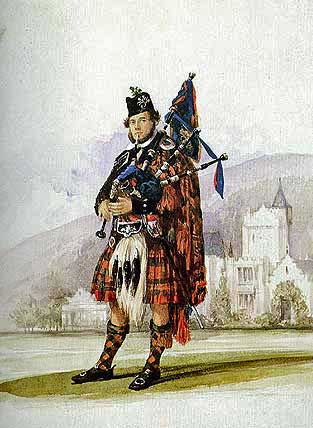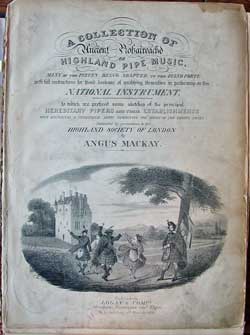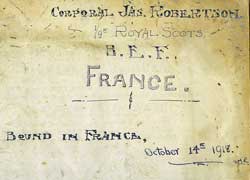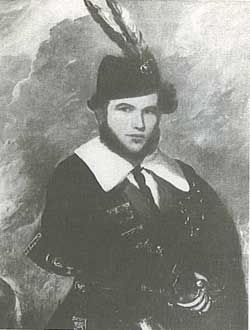Angus Mackay
(1813-1859)

If anyone in the history of piping deserves to be described as a musical genius, it is Angus MacKay. In the study and playing of piobaireachd, no compiler’s name is spoken more frequently and with more reverence. The reliance of all piobaireachd collections on his work cannot be overstated.
In his 2005 publication Pipers, Dr. William Donaldson sums up Angus MacKay’s contribution succinctly:
Angus MacKay is a towering figure in piping history. He committed more piobaireachd to paper than almost anybody else, compiled one of the biggest early light music manuscripts, containing 500 tunes, and was one of the pioneers of the ‘competition’ march.
He was born on September 10, 1813, likely on Raasay, an island off the northwest coast of Scotland. His three brothers were also pipers. His father, John MacKay of Raasay (1767-1848), was the leading composer and teacher of his generation and a revered cultural figure in the Highlands. In 1823 he moved the family from their relatively remote island home to Drummond Castle near Crieff, where he became piper to Lord Gwydir. Angus became piper to Sara Drummond, Lady Gwydir, while still a boy, later to Davidson of Tulloch, then Campbell of Islay, and finally, from 1843 until 1854, to Queen Victoria. He married Mary Russell in Edinburgh in 1841 and had two sons and two daughters.
Piping success came early, both as a player and compiler. At 12 years of age, he won a prize from the Highland Societies, not for playing, but for setting pipe tunes in staff notation. In 1826, at 13, he was fourth at the Edinburgh competition and in 1841 he won the Prize Pipe, playing “The Finger Lock” with 14 pipers competing. Donald Cameron was third. Like many pipers of his time, he competed in the dancing as well, and on this day he also took first prize as the best-dressed competitor outfitted at his own expense.

His prowess as a player, combined with his station as the first Queen’s Piper and the son of a legendary piping father, provided Angus with a lofty stature from which to influence his piping world. He did not squander the opportunity.
His Collection of Ancient Piobaireachd, published in 1838, is the considerable musical product of a man of 25 years. It contains 61 piobaireachd written in staff notation (still in its infancy, pioneered by Donald MacDonald only 16 years earlier) as well as extensive writings on the piping dynasties and the Highland Society competitions from their inception in 1781 to the date of publication. The historical material was in fact written by James Logan, an Aberdeen journalist and under-secretary of the Highland Society of London. But the musical legacy alone ensured MacKay’s place in piping history. Ancient Piobaireachd became the leading piobaireachd text-authority for generations after his death and was reprinted in 1839 and 1899. It would become the single most important published source for the early volumes of the Piobaireachd Society Collection and a major influence on how piobaireachd was played in the 19th century. But this was not all.

In 1841, MacKay approached the Highland Society of London with a proposal to publish a much larger manuscript collection containing 183 tunes – most of the known piobaireachd repertoire collected from his father and other notable pipers of the day. In a massive cultural blunder, the Highland Society declined the offer, and while what became known as ‘the Angus MacKay Manuscript’ has survived, it has never been readily accessible to players. At the time of this writing, it remains unpublished, though well studied and invoked extensively by later compilers.
Angus MacKay’s influence on light music was also considerable. He penned the original melodies of some the of great tunes in the piping repertoire: “The Balmoral Highlanders,” “The Glengarry Gathering,” “The Duke of Roxburgh’s Farewell to the Blackmount Forest,” “The Abercairney Highlanders” and the strathspey “Balmoral Castle.” In 1843 he compiled a collection of light music, called The Piper’s Assistant, with 155 tunes, which went to several editions. In 1849 he began to compile a similar collection which eventually ran to 500 tunes. But it would never see publication.
 In 1854 he was afflicted with a sudden and violent attack of apparent insanity that soon cost him his royal appointment. His later years were dogged by mental illness and he spent the rest of his life confined to institutions. He died on March 21, 1859 trying to escape from the Crichton Royal Hospital by swimming the River Nith and his body was never found.
In 1854 he was afflicted with a sudden and violent attack of apparent insanity that soon cost him his royal appointment. His later years were dogged by mental illness and he spent the rest of his life confined to institutions. He died on March 21, 1859 trying to escape from the Crichton Royal Hospital by swimming the River Nith and his body was never found.
JM, September 2007
with notes from ‘MacKay, Angus (1813-1859),’ in the ‘Oxford Dictionary of National Biography’, ‘The Highland Pipe and Scottish Society, 1750-1950’ and ‘Pipers’, all by Dr. William Donaldson; ‘The Northern Meeting, 1788-1988’, by Angus Fairrie.
Addendum, August/2018:
Of the photo at right, Peter Hewlett writes: The portrait of Angus MacKay is in the possession of the College of Piping and is by Victor Herman (my wife’s uncle), who was himself a very interesting person, having learned piping in the Gorbals Jewish Lads Brigade. Victor was a highly respected pro boxer 1948-54 and an accomplished painter and piobaireachd player, having studied with Bob Brown in London. The painting used to be in Victor’s (and his Thai wife’s) Thailand Restaurant in New Cross, South London, and was bought by a piping enthusiast who left it in his will to the College. I often stayed in the Hermans’ home above the restaurant in the 90s, and much later Rob Wallace told me, when he was director of the College, how the painting came into their possession.

6 Comments
This book was my late father’s most treasured possession. Being a first edition I take great care of it.
I’m descended from Angus Mackay through my maternal grandmother. Would love to learn more about him.
I have just found out I am a descendant of Angus MacKay. He was married to one of my ancestors. How fascinating!
I too am related to Angus MacKay through my maternal grandmother. Her brother, Donald’s grandson continues the tradition of playing the pipes. The family continue to live on the island of Raasay between the Isle of Skye and the mainland, though many of us are dispersed throughout Scotland, the UK and further afield!
That’s fantastic. I don’t suppose you have any family photos of Angus, do you?? LOL. That’s great to know the family is still of Raasay and Skye. JM
I still have the first edition printed in 1839 which my late Father, Pipe Major Gordon Asher (known as the Bearded Piper of El Alamein) , 5th Battalion Seaforth Highlanders , treasured and used when judging piping at Highland games around the North of Scotland 1960/70s.
I believe it is extremely collectable due to being a first edition.